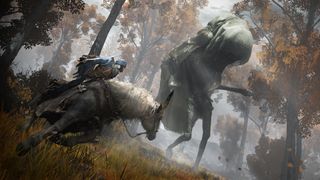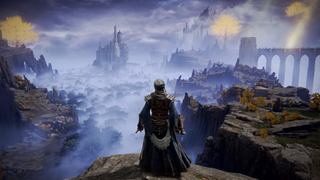Elden Ring is poised to be both the easiest and the hardest Souls game yet
Better builds will help us beat back beastly bosses.

It's funny to look back on the Taurus Demon now, the first boss you fight in Dark Souls after escaping its short tutorial area. The Taurus Demon makes an intimidating entrance, crashing down on the narrow walkway ahead of you with an enormous club in hand and horns Lucifer would envy. When you don't know what to expect, he's likely to pancake you with that club in just a few seconds. But it turns out to be a trivial fight: you just turn around, climb a ladder, and strut off a tower to stab him in the head for a huge chunk of damage. Repeat a couple times and the Taurus demon is toast. If you know where to go in Elden Ring, you can reach the first major boss even more quickly than you'll encounter the Taurus Demon, and he will almost certainly completely wreck your shit. There is no gimmick to save you.
Margit the Fell Omen is a perfect case study for how FromSoftware's boss fight design has evolved over the last decade. Somewhere between human and monster, Margit towers over you but moves with ten times the speed of the trundling Taurus Demon. He has multiple attacks to watch out for, including a jump attack with huge range and a multi-hit combo that's death if you don't dodge. And when his health gets low enough, he pulls out a big hammer to make sure you're properly scared. You can sum up the strategy for beating Taurus Demon in a couple sentences, but I wrote a whole guide for dealing with Margit.
Even the hardest boss in the original Dark Souls is easier than Margit the Fell Omen. So why isn't Elden Ring simply the hardest Souls game FromSoftware has ever made? Because it's also by far the most empowering.
In every new game FromSoftware makes bosses faster and equips them with a greater arsenal of attacks, almost-but-not-quite forcing players to memorize patterns and calmly execute hits, dodges, and blocks (there will always be a cheesy strategy if you're desperate). Regular enemies, too, are routinely far more agile than the shambling undead you run into at the start of Dark Souls. I don't know exactly what Elden Ring has in store in its deepest dungeons, but I bet there are some fights waiting that make Dancer of the Boreal Valley or even the Nameless King look like pushovers.
FromSoftware has been on the path of harder, faster, more intricate enemies since 2015's Bloodborne, and it's sure as hell not stopping with Elden Ring. But this is the first time players have gotten the better end of the deal.
Mobility is our most immediate and obvious upgrade

In a six hour preview last week, I spent the bulk of my time riding away from monsters I absolutely was not prepared to fight just so I could explore more of Elden Ring's map—where I would then run into more monsters I absolutely wasn't prepared to fight, and on and on.
Just being able to run away and decide when I want to fight feels quietly revolutionary in a Souls game. In the past, I was used to playing in one of two ways:
The biggest gaming news, reviews and hardware deals
Keep up to date with the most important stories and the best deals, as picked by the PC Gamer team.
- Cautious progression, inching forward to clear out enemies and hold onto the souls I collect for each kill
- Suicide run, trying to dodge every enemy during a reckless charge to the next bonfire or boss fight
Elden Ring lets you switch between the two on the fly. Fighting a few small fries and spot an imposing enemy coming towards you? Whistle for your spectral steed, hop on, and book it to safety.
Reaching most boss fights is no longer a gauntlet
Sometimes reaching a boss in the Souls games means fighting through (or dodging past) piles of enemies, leaving your healing flask inventory dangerously low. But most of the bosses in Elden Ring I've encountered live in mini dungeons that take only a few minutes to clear out, or they're fightable right in the overworld—either way, it's pretty easy to roll up to them at full fighting strength.
In general you're much less likely to lose more than a few minutes of progress in Elden Ring, at least out in the open world. Stakes of Marika are plentiful and act as respawn points when you die—you can't use them to fast travel or restock your supplies, but you can often respawn within spitting distance of your dropped runes (aka souls) and easily reclaim them. Elden Ring may still require you to repeat the same fight multiple times, but it's cutting out a lot of the tedium.
You can always just… go somewhere else

I spent hours in last November's Network Test exploring the first area in Elden Ring and fighting my way to Margit the Fell Omen. For this new preview I wasn't too interested in doing that again, and I knew I wasn't leveled up enough to take on the lord of Margit's castle, Godrick, who'd be even tougher. Instead of spending hours trying to kill him I just avoided the castle altogether, finding a route around it to instead explore Elden Ring's second major area.
I'm sure I'll stubbornly throw myself against at least one Elden Ring boss over and over again when the full game arrives, but from what I've seen you can access a huge portion of Elden Ring's world from the very beginning. That means many, many options for how you progress.
New challenge: Elden Ring's open-endedness could end up making your leveling progress feel slower than in past Souls games. Dark Souls encouraged cautious exploration and then incremental leveling at a bonfire, but in my six hours with Elden Ring's preview I mostly rode around the world dodging enemies. I barely leveled up and usually didn't bother retrieving my runes after dying because I wanted to go somewhere new instead of retrieving them. There's less extrinsic motivation to advance now.
Upgrading weapons is now so much easier
Finding or building a weapon that scales with a particular stat like Intelligence or Faith was tough in the older Souls games, and you usually couldn't get the upgrade materials you needed to enhance them until deep into the game. In Elden Ring, you can make those kinds of upgrades far more easily with resources accessible in the first area, even. You can be the wizard you want to be while also whacking things with a sword.
The guard counter is seriously powerful
You could risk parrying an attack in Elden Ring and eat a ton of damage if you get the timing wrong. Or you could huddle up behind a shield, take a hit, and counter with a free whopper of a hit.
The open world makes it easy to find grinding spots
Elden Ring is an RPG, and RPG players love to find advantageous grinding spots and exploits for lucrative item drops. In my short preview of Elden Ring, I ventured far afield to an area I definitely wasn't equipped to handle, but made it to a Site of Grace (aka a safe 'bonfire' that acts as a fast travel point) near a building full of enemies. They could kill me in one or two hits, but if I got in a flurry of sword blows I could stun one and kill it, then run back to the Site of Grace. Repeating that for 20 minutes got me a few easy level ups that would've required killing dozens of enemies in the opening area. I'm sure there are much better spots to quickly grind out some XP, too.
New challenge: You can definitely find opportune places to level up, but that flexibility also means you'll be running into enemies that can absolutely destroy you with regularity. In the older Souls games, it was generally obvious if you'd stumbled into an area that outleveled you, and there was usually a single 'main' path for inexperienced players to follow. Elden Ring trusts you to figure out where you should be going and what kind of ass kicking is level-appropriate.
Stealth makes backstabs easy
Elden Ring borrows Sekiro's stealth system to let you crouch in bushes and sneak attack enemies. It's not a complex stealth system, but it does let you get some high damage backstabs in. There are even some boss fights that you can start from a stealthy advantage.
There's no such thing as 'hollow' anymore
In most Souls games you have to choose between human form, which lets you play online and buffs you with considerably more health, or hollow form, where you can't be invaded by online tricksters but sacrifice co-op, that extra HP, and other advantages. Die and you lose your human status, forcing you to use an item or kill a boss to get it back.
That system's gone in Elden Ring. Dying barely penalizes you anymore (though you are still going to lose all the runes you had on you). And you can't be invaded while playing solo anymore—evil players will only find their way into your game when you're in co-op. That's downright player-friendly!
There's a dang map
The Dark Souls series eventually added in generous fast travel that trivialized the process of learning how to get from one part of the world to another. But the first game, especially, required you to build a mental map in your head so you could race directly from Firelink Shrine to Blighttown on your second run. They never, ever gave you a map. But Elden Ring does, along with a compass and the ability to mark up to five points of interest for easy wayfinding. Standard for open world games, but absolutely wild for a Souls game.

Wes has been covering games and hardware for more than 10 years, first at tech sites like The Wirecutter and Tested before joining the PC Gamer team in 2014. Wes plays a little bit of everything, but he'll always jump at the chance to cover emulation and Japanese games.
When he's not obsessively optimizing and re-optimizing a tangle of conveyor belts in Satisfactory (it's really becoming a problem), he's probably playing a 20-year-old Final Fantasy or some opaque ASCII roguelike. With a focus on writing and editing features, he seeks out personal stories and in-depth histories from the corners of PC gaming and its niche communities. 50% pizza by volume (deep dish, to be specific).
Most Popular


